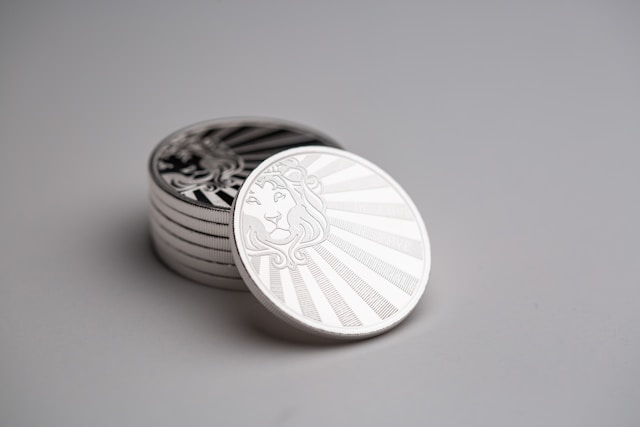Some consider silver a reliable hedge against inflation, a safe haven during economic uncertainty, and an asset with growth potential. Globally, 2023’s mine production of silver was estimated to be around 26,000 metric tons. That same year, however, silverware demand fell by 25% to 55.2 Moz, and silver jewelry fabrication experienced a 13% drop, with losses mainly in India who’d seen an apex of silver demand the previous year. For those looking to diversify their investment portfolio, the question stands: is silver a good investment?
While silver shares many qualities with gold as a precious metal, its volatility, industrial demand, and price fluctuations make it a unique investment. To understand whether silver is a good investment in 2024, it’s essential to consider market trends, economic conditions, and the factors driving silver’s price.
Understanding Silver As An Investment
Silver, like other precious metals, has been used for centuries as a store of value. It has various forms, including coins, bars, and exchange-traded funds (ETFs), offering different ways for investors to add it to their portfolios. The electronics, solar panel, and healthcare industries all make use of silver, thus making it both a financial and industrial commodity. Its dual role as a precious metal and industrial material contributes to its price volatility, as both financial speculation and industrial demand drive its value.
The State Of The Silver Market In 2024
Silver’s price has seen fluctuations, but it remains within a range that offers opportunities for both short-term traders and long-term investors. As of December 2024, silver’s price was hovering around $30 per ounce, a level that represents a solid base for the metal. The global silver market is currently in a four-year-long physical deficit this year, with record industrial demand and an uptick in those silverware and jewelry demands, peaking at 1.21 billion ounces. Mine supply, however, will rise by a meager 1%.
Several factors contribute to silver’s market movement in 2024. For one, inflation rates and economic uncertainty have led many investors to seek out tangible assets like silver as a store of value. Additionally, rising industrial demand, particularly in the green energy sector—where silver is a key component in solar panels—has created upward pressure on its price. If these trends continue, silver could see more price appreciation throughout the year.
Recently, gold has experienced a price hike due to central bank buying. However, those same institutions are not buying silver. Russian entities have announced plans to buy silver, which might lead to a buying trend for the precious metal.
Pros Of Investing In Silver In 2024
Silver offers a number of potential advantages for investors looking to diversify their portfolios in 2024:
Inflation Hedge: Just like gold, silver is often seen as a safe haven during periods of high inflation or economic instability. With inflation concerns still present in many economies, silver’s ability to retain value during times of financial uncertainty makes it an attractive option.
Industrial Demand: The growing use of silver in industries such as electronics and renewable energy (especially solar power) has created a strong demand that could drive prices higher in the coming years. As the push for green energy continues, silver’s industrial uses could result in a more consistent and rising price trend.
Diversification: Silver can help balance risk in an investment portfolio. As stocks and bonds can be volatile, holding silver provides exposure to an asset that behaves differently from traditional financial markets.
Cons Of Investing In Silver In 2024
However, silver comes with its risks, and potential investors should carefully consider the following drawbacks:
Price Volatility: Unlike gold, silver is more volatile due to its industrial applications. Economic changes, especially fluctuations in industrial demand, can cause significant price swings. This volatility makes silver a riskier investment compared to other more stable assets.
Market Sentiment: Silver’s price is heavily influenced by investor sentiment. If demand for silver in the jewelry or industrial sectors decreases, the metal’s price can fall significantly, especially since a large portion of silver’s value is driven by speculation in financial markets.
Storage and Security: Physical silver, whether in the form of coins or bars, requires proper storage and insurance, which can be costly. For some investors, owning physical silver may not be the most practical option due to these additional expenses.
Silver Vs. Other Precious Metals In 2024
In 2024, investors also have the option to consider other precious metals, such as gold, platinum, or palladium. Gold continues to be the most sought-after precious metal, providing stability and long-term value, especially during times of economic instability. While silver’s price is more volatile, it offers more potential for growth due to its dual nature as a precious metal and industrial commodity. Investors looking for a mix of stability and growth potential might find silver to be a more appealing option than gold, which has fewer industrial uses.
Conclusion
Whether silver is a good investment in 2024 largely depends on the investor’s risk tolerance, market outlook, and portfolio needs. While silver offers significant upside potential due to industrial demand and its role as a store of value during economic uncertainty, its volatility and price swings make it a riskier option than some other assets. For investors who understand its dynamics and are willing to embrace some uncertainty, silver remains a potentially rewarding addition to a diversified portfolio.
















